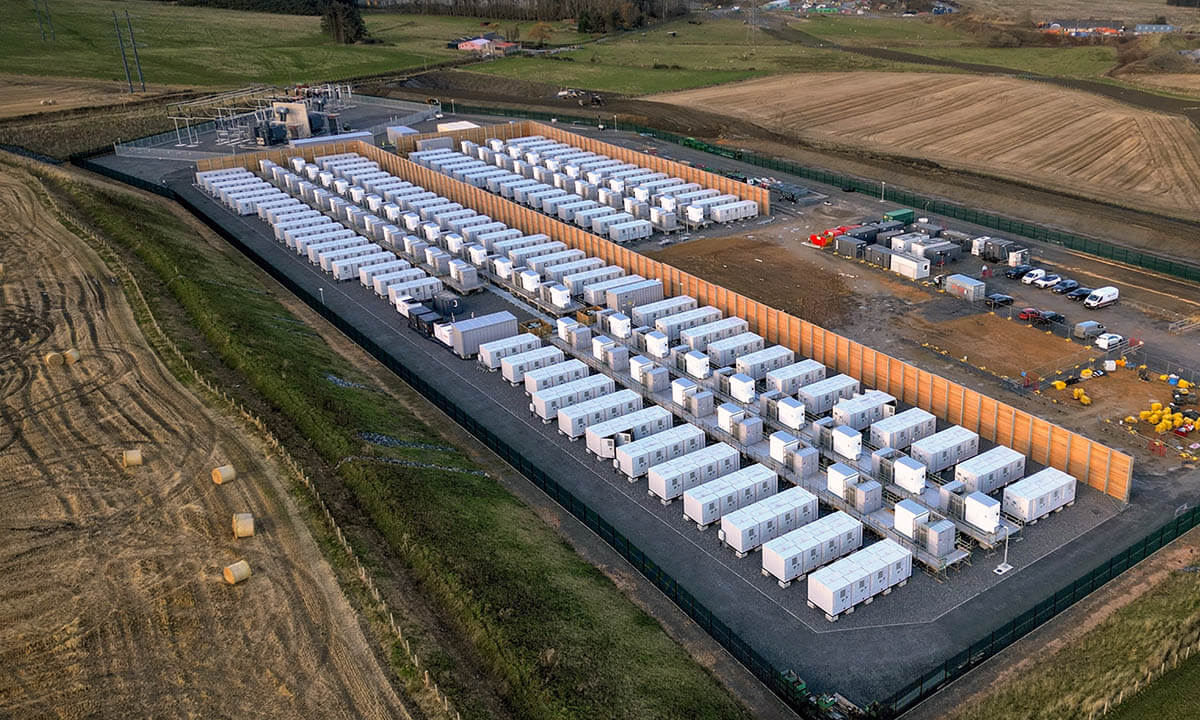Building Blackhillock: Stacking services to power bigger, better battery systems
“Stacking services” refers to battery energy storage systems (BESS) providing multiple benefits to grids across the world. While the GB market is among the most advanced, the full potential of battery storage has yet to be realised in reducing costs for British consumers. In this article, we’ll dive into why one of the world’s most advanced BESS sectors is not yet achieving its full potential – and what can be done.
The critical role of battery energy storage
Batteries ensure the lights stay on, keep the costs of energy down and ensure we’re not wasting abundant renewable resources
Batteries provide a multitude of services to the energy grid
Great Britain’s energy market is one of the most advanced in enabling revenue stacking, allowing a single asset to deliver multiple services .
At Zenobē, we deliver 13 different grid services across our portfolio. This approach benefits consumers by maximising efficiency, as it utilises one asset to perform various functions, instead of building multiple assets each dedicated to a single function.
It hasn’t always been this way. The role of batteries has evolved significantly over time, due to several factors. In 2017, when Zenobē was founded, battery systems were smaller and typically had a duration of just 30 minutes. This meant they could only provide a specific grid service for this period.
Initially, the system operator – now known as National Energy System Operator (NESO) – exclusively used batteries for Fast Frequency Response, which helped to maintain the 50 Hz of frequency needed for a functioning energy grid. This was driven by both higher battery system costs, as well as the design of NESO’s systems and markets.
As battery system durations have increased, and NESO has begun to understand the full potential of batteries, they have been mobilised in a wider range of services, including energy balancing in markets dominated by intermittent renewable sources such as wind and solar.

Batteries are key to achieving the Government’s target of Clean Power by 2030
Zenobē envisions an expanded role for batteries in supporting a renewable energy system. Achieving the government’s Clean Power by 2030 goal requires more than just building wind farms and solar farms . A renewable-based energy system can provide security of supply when supported by flexible, dispatchable power sources, such as battery energy storage.
Furthermore, batteries not only balance supply and demand, but also help ease grid constraints and maintain grid stability, ensuring a more efficient and resilient energy network.
Zenobē successfully secured a Stability Pathfinder contract for Blackhillock, enabling it to deliver critical services designed to tackle grid stability challenges, as renewable energy integration accelerates. When NESO launched Phase 2 of the Pathfinder programme, it focused on procuring solutions in partnership with industry, to strengthen short circuit levels and enhance inertia – with a particular emphasis on Scotland. NESO’s innovative use of Pathfinders to procure solutions shows the wider potential for batteries to contribute to reducing system inefficiency and cost and the potential for co-designed solutions to solve the specific challenges of a renewables grid.
Whilst initiatives like the Stability Pathfinder provide a valuable testing environment, NESO must take further steps to realise the potential of battery storage and deliver market solutions that encourage competition and drive down costs for consumers, such as Constraint Management Markets.
Expanding the use of batteries for grid solutions will be key to achieving a clean power system at the best cost to consumers, as demonstrated by Blackhillock.
Recognising batteries as critical national infrastructure
The ability to stack multiple services provides a strong foundation for the deployment of battery storage in Britain. However, the problem is that batteries are not currently treated properly in its energy system, which was designed for an era dominated by continuous baseload power from fossil fuel plants – not the distributed and intermittent nature of renewables.
Although some progress has been made, the system’s design and functionality still contains inherent biases that disadvantage batteries.
1. Fix constraint ‘skips’ once and for all
Even though batteries are a cheaper and more flexible option, NESO currently prefers to switch off wind farms rather than utilise batteries. While NESO has committed to increase their use of batteries, this must happen swiftly to avoid further unnecessary costs for consumers2.
2. Stop treating batteries like fossil fuel generators in transmission charges
Battery storage helps cut network costs by importing electricity when needed. But outdated rules treat them like fossil generation and ignore this import capability. Rule changes to the Transmission Network Use of System (TNUoS) are needed to fix this.
3. Ensure a level playing field for competition
Batteries don’t need government subsidies, but they have to compete against Government-subsidised assets such as wind farms in markets like the Balancing Mechanism (BM), where batteries are already disadvantaged by a short dispatch period. While government support to build renewables is necessary, fair competition between clean technologies should not be distorted to avoid inflating system costs.
If more battery systems like Blackhillock are to be built, whilst Government investment is not required, sufficient markets and regulations are. Achieving the full potential of the British energy storage sector means fine-tuning our power markets and bringing outdated regulation up to speed.
To truly unlock the value of battery storage, Government, NESO and Ofgem must go further in recognising batteries as critical national infrastructure that is essential to delivering a clean, secure and affordable energy system. This means ensuring that market design, procurement processes and regulatory frameworks fully reward the unique flexibility and system value that batteries offer.
Without intentional reform and targeted adjustments, the UK risks underutilising a world-leading technology and missing a low-cost pathway to Clean Power in 2030 and beyond. Batteries like Blackhillock show what is possible, now policy must catch up to the potential.
Georgina Morris-Rowbottom, Public Affairs and Policy Lead
1Consumer savings of £170m reflects savings of £9m from the Stability Pathfinder contract and savings of £164m from providing balancing services and constraint management to the grid and helping reduce price volatility. The £9m of consumer savings assumes that the stability contract (9-10yr contract length), secured for Blackhillock project, will avoid the use of CCGT’s, which would otherwise be out-of-merit, to provide inertia and SCL. CCGT efficiency assumed at 55% and Stable Export Limit of 35%. Average gas price over contract length assumed at £40/MWh, which is conservative considering the high price outlook for gas over the next decade. The £164m of balancing services and constraint management assumes that the asset cycles twice a day and provides a reasonable level of savings to the control room vs the alternative actions that would be taken e.g. curtailing wind for bid actions during constraints, more competitively priced offer actions than gas peakers / CCGTS.
2NESO refers to battery skips as “when a non-economic dispatch decision is made.” https://www.neso.energy/document/348241/download
Blackhillock – Europe’s largest battery
Zenobē’s transmission-connected battery in Blackhillock, located between Aberdeen and Inverness in Scotland, is the first in the world to deliver Stability Services using a transmission-connected battery. Going live at the end of February 2025, it is increasing the uptake of renewable power onto the GB electricity grid, including that from large offshore windfarms at Viking and Beatrice in the north of Scotland.
Versatile battery systems like Blackhillock are the Swiss Army knife of modern energy infrastructure – providing reliability, efficiency and sustainability.
Blackhillock is uniquely positioned to stack services, leveraging Zenobē’s innovative system design to rapidly respond to market signals and meet the evolving demands of the energy system. This flexible, future-facing approach represents a model that can be applied globally, helping energy systems worldwide transition to more resilient and efficient operations.
At Blackhillock, Zenobē has appointed Kraken and EDF to navigate the complexities and opportunities of service stacking. Using advanced software and algorithms, EDF Energy makes real-time decisions on whether to charge or discharge. By analysing market conditions, electricity prices, grid demands and contractual obligations, they ensure the battery is utilised in the most effective way possible.
Driven by falling costs, longer durations and a growing appreciation of the capabilities and value of battery systems, the landscape in 2025 looks very different. When fully built, Blackhillock will be a 300MW / 600MWh project. It is the first to provide the full suite of active and reactive power services in the world and is the largest transmission connected battery in Europe.
The additional renewable energy resources and increased efficiency provided by Blackhillock will accelerate energy independence and lower consumer bills by over £170 million over 15 years1.
